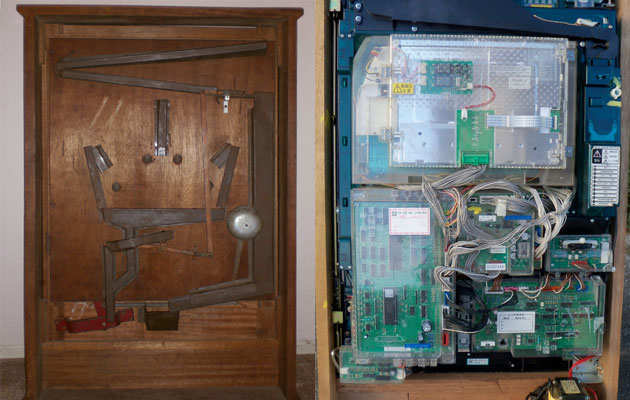Even though I was way too young to gamble the first time I visited Japan, pachinko really interested me. My dad tried to take us into a pachinko parlor to see what the hubbub was about, but the staff quickly spotted a then 10-year-old Hashi and kicked us out.
During Tofugu’s trip to Japan this year, I decided to give pachinko a try since I was finally old enough. I put in my hundred yen coin and my eyes glazed over as lights flashed, a screen lit up, and little silver balls bounced around.
I didn’t understand a damn thing that was going on, but I won a small prize and decided to retire at the top of my game.
Pachinko is a huge industry in Japan. It’s raked in incredible profits over the years, and played all across Japan. When we visited, we saw people lining up at pachinko parlors before they’d even opened.
How does the pachinko industry keep people interested? After all at its core, pachinko is an extremely simple, not very interactive game. But to keep this multi-_trillion_ yen industry afloat, the industry has a lot of incentive to keep players entertained.
Technological Advancements

The podcast 99% Invisible recently did a really interesting story about the evolution of slot machines in the US. What started out as a one-armed bandit has turned into a monstrous, complex, computerized machine that uses sophisticated algorithms to slowly bleed people of their money.
When I thought about it, I realized that the same thing has more or less happened with pachinko machines.
They started out simply enough. Even I could probably build a pachinko machine the way they were built in the early days. Get a wooden board, hammer in a few nails, drill a few holes, and you more or less have an early, primitive pachinko machine.
But if you crack open the back of a modern-day pachinko machine, you’ll see something that looks more like a computer than a woodworking. Circuit boards, wires, and power supplies line the inside power the modern pachinko machine.
The site Vintage Pachinko has a great visual history of pachinko machines from the 40s to current day, showing both the front and the exposed back of the machines. It’s astounding to see how the electronic parts and circuitry grow exponentially over the decades.
Flashing lights and speakers on machines catch a player’s attention. Features like rapid-firing pachinko machines and motorized handles let players go through balls quicker (and therefore spend more money), and the math behind the placement of the nails within the machine have gotten increasingly sophisticated.
The technology is only one half of the equation. The variety of the machines, whether it’s the branding, the type of game, or the price, also play a big part in bringing in players and keeping them planted in front of the machines.
Variety
You can only do so much with technology; at some point, you have to go beyond the circuitry and appeal to customers in other ways.
Branding

Pachinko machines are cycled out of parlors at an astounding rate, not only to keep up with technological advances, but to also keep up with the current cultural trends too.
In Japan, I saw lots of pachinko machines that branded themselves after pop culture staples like AKB48 and the newest Evangelion movie. Foreign franchises get their own pachinko machines too, like Western movies or Korean dramas.
While your everyday pachinko addict probably doesn’t care too much if some pop star is staring back at them while little metal balls bounce around the machine, they appeal to hardcore fans and might draw people into pachinko parlors who otherwise might not be there.
Plus, it gives the parlors a sense of being current and relevant. See, we know what the kids like! AKB48! Now who wants to play some pachinko?
Games Within Games
If you don’t have the licensing rights to stick a celebrity’s face on the front of your pachinko machine, what else can you do to differentiate your game? For one, you can add on new functionality.
You’ll see a lot of machines nowadays incorporate slot machine functionality in to pachinko by using the screen in the middle of the machine. Balls landing in certain spots trigger the machine to start spinning and basically start another game altogether. It’s like a game within a game!

There’s also variance on how much you can bet on a machine. Balls for a pachinko machine vary in price a little bit, the way that slot machines do—you might have slot machines that take quarters, but there are also nickel and penny machines too.
Same goes for pachinko. Per ball, prices range anywhere between ¥1-¥4. The lower prices can lure in players and cause them to accidentally spend a lot more money. The difference in price may not seem significant, but when you tally all of the balls that players go through in a typical game of pachinko, it really adds up.
There’s nothing wrong with playing a little pachinko here and there; hell, some people are actually about to make a living out of it. But just remember that a multi-trillion yen industry has spent decades designing machines to keep your butt planted squarely in front of a pachinko machine for as long as possible. Have fun!
